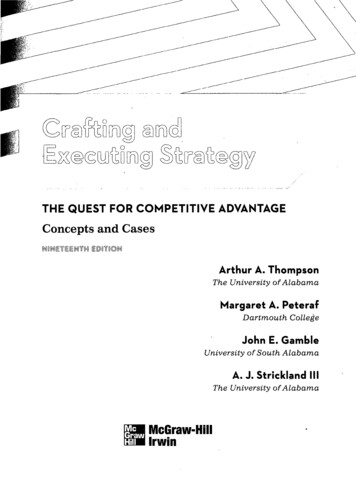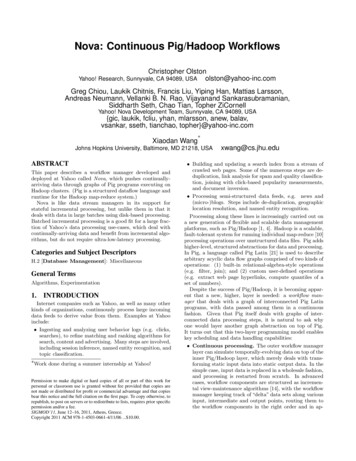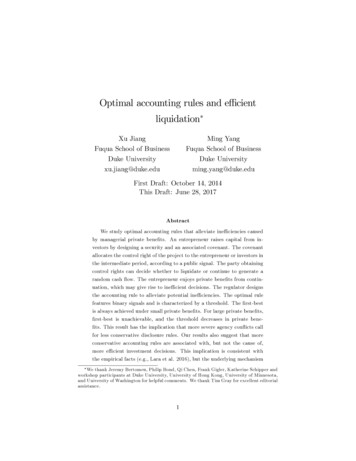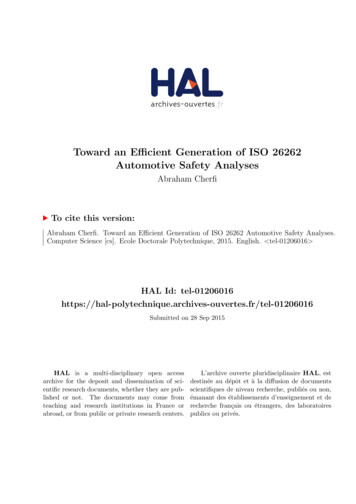
Transcription
A Low-Cost Efficient Wireless Architecture for Rural NetworkConnectivity1IntroductionMany rural regions around the world, especially in developing regions, do not have good connectivitysolutions which are economically viable. As a result, many of these regions remain disconnectedfrom both the rest of the world and from progress in general. In this proposal, I will describethe design of WiFi-based Rural Extensions (WiRE), a new wireless network architecture that canprovide connectivity to rural regions at extremely low costs. The WiRE architecture is tailored forthe typical rural landscape in several developing regions, in which the population is spread acrosssmall but scattered rural regions (less than 1-2 sq kms) within 100-200 kms of the city. WiREis designed to be a wireless distribution network that extends connectivity from the city to eachvillage.The WiRE architecture has largely been inspired by my prior work on WiFi-based LongDistance (WiLD) Networks [42, 62, 35, 54, 64, 34], a low cost point-to-point network connectivitysolution that provides very high bandwidth (typically 6 10 Mbps) over very long-distances. Whileprior work on WiLD networks [48, 5, 42, 62, 35] has made significant progress in the design of highperformance MAC layer solutions, we still lack a vision of how to design a comprehensive, low-cost,rural connectivity architecture that can efficiently support a wide-range of applications. It is thisgoal that I wish to achieve in the WiRE network architecture design. To realize this architecturalvision, we need to address several challenges at various protocol layers including the MAC, network,transport and the application layers. We will first motivate the need for low-cost connectivity beforewe outline these challenges in greater detail.Motivation: Need for Low-Cost Rural ConnectivityAs of Internet World Stats 2007 [28], the Internet penetration in North America is 69.7% of thepopulation compared to 10.7% in Asia and 3.6% in Africa primarily restricted to urban areas. Thefundamental problem in connecting rural regions is economics [34, 9, 8]. None of the traditionalwire-line connectivity solutions (fiber, broadband and dial-up) are economically viable for suchregions over at least the next decade due to low user densities [34, 15, 9]. Satellite networks providegreat rural coverage but at very high costs: the ISP rate for 1 Mb/s of satellite connectivity inAfrica exceeds 3000/month [3].In recent years, many developing countries have undergone a cellular revolution with a significant penetration of cellular networks in rural areas [26, 27, 23]. Commercial wireless broadbandnetworks based on GPRS [55], WiMax [70, 22] and CDMA [36] technologies are also being widelydeployed [36, 27, 26]. While a sizable fraction of the rural population owns cellphones for telephonyservices in Africa and Asia [46, 26, 71] the network usage is limited due to exorbitantly high usagecosts, roughly ranging from 10 cents to 1/min [2, 24, 23, 25]. Given that a large majority in ruralareas earns less than a few dollars/day, these costs are unaffordable.For any connectivity solution to be economically viable in rural regions with low-user densities, it is essential to have small per-user setup cost and minimal recurring costs [62, 34]. Networkswith a base-station model, such as WiMAX, and cellular networks like GPRS and CDMA, havean asymmetric design philosophy where expensive base stations (costing roughly 10K - 100K depending on range and capacity) are amortized by large number of cheap client-devices over manyusers [62, 34]. Operational costs of these networks in rural areas are also high [34, 64] due to: (a)1
Figure 1: Aravind networkFigure 2: The WiRE network architecturesignificant power consumption to cover large areas; (b) the need for backup power due to lack ofreliable grid power; (c) high cost of physical security for expensive equipment. Together, these costsmake existing cellular and wireless broadband services not viable in regions with low user densities.Hence, the expectation that cellular solves the connectivity problem for rural developing regions isthus somewhat of a myth!Prior Experiences on Rural Connectivity: Prior to this proposal, I was involved in thedesign, implementation and deployment of WiLD networks [42, 35, 62, 64], a point-to-point WiFiconnectivity solution that can provide 6 10 Mbps over 50 100 kms at very low costs. WiLDnetworks are extremely low-cost due to the use of unlicensed WiFi spectrum and leverage offthe-shelf low-cost and high available commodity hardware. To achieve high throughput in WiLDnetworks, we designed a new MAC protocol called WiLDMAC that addressed many of the criticalshortcomings of the conventional 802.11 protocol in long-distance environments. WiLDMAC alsoimproved over 2P [48], the only previously known protocol for WiLD environments, by being ableto achieve high throughputs over highly lossy network environments (20-60% loss rates). Recently,we developed JazzyMAC [35] that significantly improves over both 2P and WiLDMAC to achievenear-optimal throughput in multi-hop settings. WiLD networks have become increasingly popularin the last few years with deployments in nearly 15 20 developing countries. Our WiLD networkdeployment for Aravind Eye Hospitals [21] in South India (illustrated in Figure 1), the largesteye hospital in the world with over 2 million patients per year, provides telemedicine services toover 50000 patients per year in 13 rural vision centers [64, 63]. Aravind Eye Hospitals recentlyobtained a Gates Foundation grant to expand their network to cover 500000 patients per year. Wealso broke the world record for the longest point-to-point wireless link achieving 6 Mbps over 384kms in Venezuela [64]. Other WiLD deployments include the Digital Gangetic Plains project [48],Fractel [11], the AirJaldi [37], Aravind networks [64] and the Akshaya network [66, 41].Other Connectivity Approaches: There have been a few recent WiFi-based solutions [51, 43]which have proposed MAC extensions for point-to-multipoint networks. We discuss these in greaterdetail in Section 3. An alternative economically viable connectivity approach is to use DelayTolerant Networks (DTN) [16, 31, 30, 19, 44, 68] which leverage physical transportation systemsto transport bits to and from the rural regions. DTNs by definition are not suited for interactiveapplications which is an important focus of the WiRE network architecture.2
Research AgendaWiRE uses a network structure (illustrated in Figure 2) that is significantly different from thetraditional cellular, WiMAX, WiLD, and wireless mesh network models. For comparison, an example WiLD network is illustrated in Figure 1. Unlike the cellular network philosophy of providingbroad network coverage, WiRE provides focused coverage within rural regions with little coverageoutside. The network structure of a WiRE deployment is optimized based on the topography andthe spread of rural regions. To efficiently reach out to sparsely spread out rural regions, WiRE usesa combinational network structure with four important components: (a) point-to-point networklinks; (b) point-to-multipoint network links; (c) local distribution mesh networks; (d) cellphonesas end-devices in addition to PCs and kiosks. Given that land and tower costs are expensive, thisnetwork structure explicitly attempts to achieve maximum distribution with a small set of towers.While point-to-point links with highly directional antennas provide a high bandwidth backhaulthat can cover long distances, point-to-multipoint links with sector antennas provide efficient distribution capabilities within shorter regions and mesh networks with omni-directional antennas areprimarily used in small localities to provide coverage.The use of cellphones in WiRE as end-devices is very important especially given the masspenetration of these devices in rural regions [23, 20, 26]. Many rural deployments which usesPCs, kiosks and other types low-cost computing devices have miserably failed due to complexuser interfaces and the sheer lack of need [32, 33]. Nearly 100,000 kiosks deployed in rural Indiaare being sparingly used [33, 17]. Cellphones, on the contrary, have gained significant acceptanceamong rural communities as they are simple to use, and are also accessible to the illiterate usercommunity. Cellphones, in rural communities, are predominantly used as a voice interface [20],which is the main reason why telephony services remains the most important killer application inthese environments [41]. Also, according to a recent study [56], most phones in the near futureshould have inbuilt WiFi capability [56].To realize the WiRE network architecture, we need to address several challenges across different network layers:MAC layer Challenges: Designing a unified high-performance MAC layer for the WiRE architectureis a challenging problem. WiRE uses three different types of network links (point-to-point, pointto-multipoint, omni) each with completely different network characteristics all of which operateon the same frequency band. To achieve this, we need to address several specific challenges: (a)develop new MAC protocols for point-to-multipoint; (b) handle complex interference interactions;(c) adapt to highly lossy links; (d) intelligent channel assignment; (e) adapt to fluctuating trafficdemands.Robust Network Design Challenges: Designing robust and reliable rural wireless networks is anarduous task due to a variety of factors: failure of cheap devices, lack of good and stable powersources, lack of good local support, nodes in hard to reach locations. We intend to build a suiteof solutions including: (a) efficient topology design and routing to handle frequent outages whileminimizing the need for new towers; (b) efficient low-cost power solutions including solar powersolutions; (c) network management tools that can aid in configuration, fault diagnosis, monitoringand remote management/upgrades.Application Specific Challenges: Apart from traditional set of Internet applications, we requireWiRE to support specific applications of prime importance to the rural sectors including telephony,telemedicine, distance learning and mobile banking services. To enable these applications, we needto address two broad set of challenges. First, for telephony, video-streaming and video conferencingapplications, we need to address the challenge of providing statistical end-to-end QoS guaranteesin the face of fluctuating loss and available bandwidth variations. Second, to enable telephony and3
secure mobile transactions, we need to be able to support mobility of cellphones within the WiREnetwork and also provide a secure naming mechanism based on the unique identity of cellphones.Intellectual Merit: Computer science, as a field, has paid very little attention to importanttechnical challenges that arise in the developing world. This proposal will significantly advance theunderstanding of networking challenges across all protocol layers in the developing world. Thisproposal will also advance the understanding of several fundamental aspects of wireless networkdesign including interference, high-throughput, QoS, routing and transport issues.Broader Impact: The WiRE architecture has the potential to significantly transform therural landscape by providing network connectivity at very low costs and impact billions in ruralregions who still remain disconnected from the rest of the world. We intend to do pilot deploymentsof the WiRE architecture in India, Ghana and South Africa where we work with well establishedlocal partners who have the capacity to reach out to millions in rural communities.2WiRE Network ArchitectureIn this section, we describe the WiRE network architecture and discuss important real-world challenges in deploying rural wireless networks based on our experiences. Figure 2 describes the basicWiRE network architecture. Unlike the traditional cellular model of providing broad coverage,the design philosophy of WiRE is to provide focused coverage within specific rural regions whereconnectivity is most required. The WiRE architecture has six important network components:1. wireless nodes which are low-power single board computers that have the capability to supportmultiple wireless cards for different network links.2. point-to-point links using highly directional antennas to provide network connectivity overlong distances in the range of 50 100 kms.3. point-to-multipoint links using sector antennas to distribute connectivity to multiple endpointswithin relatively short distance lasting a few kilometers.4. multi-radio mesh links using omni-directional links to extend wireless coverage within smalllocal regions.5. cellphones or low cost computing devices with WiFi-enabled interfaces that can act as enddevices.6. large local storage of at least a few GB at each local wireless node to perform in-networkoptimizations for applications as well as store-and-forward intermittent operations in theevent of a network outage.The basic network structure of WiRE is a natural extension of WiLD networks, which I hadworked on for the last three years in collaboration with Prof. Eric Brewer and his students atUC Berkeley. The focus of the WiRE network architecture is much broader in scope than WiLDnetworks. WiRE focuses on challenges across different protocol layers to build a complete solutionfor rural connectivity including support for a wide range of applications. Even from the MAClayer perspective, WiRE operates in a combinational wireless environment of point-to-point, pointto-multipoint and omnidirectional links, each of which have completely different MAC needs andinterference characteristics.WiRE has the flexibility to operate in any frequency spectrum. However, for practical andcost-related constraints, we choose all network links in WiRE to operate in the WiFi frequencyband space (802.11 a/b/g). WiFi cards are cheap and highly available, enjoying economies ofscale. The typical cost of a network link excluding the cost of the tower can be brought down toapproximately 600 (excludes the cost of tower) with no recurring cost. Since WiFi is classified asunlicensed spectrum in most countries, a WiRE network provider does not need to pay spectrum4
costs which can be significantly high for other licensed frequency bands. The use of WiFi alsomakes WiRE easy to deploy and experiment with given that the entire network is composed ofcheap off-the-shelf components. Manufacturers of WiFi chipsets (e.g. Atheros) often support opensource drivers, allowing us to completely subvert the stock 802.11 MAC protocol and tailor theprotocol to meet our needs. All these factors promotes decentralized evolution of WiRE where agrass-roots organization can easily deploy a WiRE network without any dependence on a telecomcarrier.In WiRE, every wireless router uses a low power single board computers (SBC). The currenttypical configuration of a SBC has a 466 Mhz processor, 256 MB RAM and can support upto 4wireless cards; in addition, we equip each wireless node with a large local storage to enable innetwork application-level optimizations and also perform store-and-forward routing in the face ofnetwork disruptions. For radios, we use off-the-shelf high power 802.11 a/b/g Atheros cards withup to 400 mW transmit power. For long-distance point-to-point links that can traverse between20 150 kms, we use high power radio cards with high-gain parabolic antennas with a gain factorof upto 30dBi. The highly directional nature of the wireless beam allows us to have several pointto-point links at a given node given multiple radios. For connecting many specific locations withina certain distances of upto 20 kms, we use a point-to-multipoint topology where a single wirelessrouter can serve as a base station for several clients. Depending on the bandwidth requirements foreach client, each node can serve upto 30 clients. The multi-radio mesh nodes within a local regionare used for extending the connectivity within a specific region; these links in outdoor settings with200mW cards can cover between 0.5 kms to 1 km. If necessary, depending on the topography of aregion, we may require several multi-radio mesh nodes to completely cover a region.The end-devices in WiRE can be either static computing devices such as PCs/kiosks ormobile devices such as cellphones. It is essential for cellphones to form an integral part of theWiRE architecture due to three factors. First, cellphones have such high penetration levels in ruraldeveloping regions that make them natural candidates for end-devices. Many of the new generationof low-cost cellphones come with inbuilt WiFi capabilities making them suitable for WiRE. Second,cellphones are extremely simple to use and are accessible to even illiterate users in rural areas.Finally, the open source movement for cellphones [65, 18] has radically transformed the set of newapplications that can be deployed for these devices.Rural Specific Applications: Apart from the traditional set of Internet applications (web browsing, Email etc), we require the WiRE architecture to enable specific services which are very important in the rural context. Many rural regions have remained disconnected from the rest ofthe world that the state of several essential services such as education, healthcare and financialservices have remained abysmal in these regions. Providing connectivity alone is not sufficient; werequire WiRE to support the appropriate set of applications to enhance essential services in ruralareas. We have identified four such applications which we deem as essential for WiRE to support:(a) telephony services for cellphones; (b) telemedicine and teleconsultation services for improvingrural healthcare; (c) interactive distance learning to improve rural education; (d) mobile bankingto promote rural financial services. In order to enable each of these application, we need to addressspecific challenges in the network and transport layer. We outline these challenges and our initialapproach to address them in Section 5.2.1Challenges Building Rural Wireless Networks: Lessons LearntIn our experiences in deploying wireless networks in rural areas, we faced several challenges dueto the ground realities of these regions. We document our experiences in our prior work [64]. Weillustrate the important lessons we learnt from our deployment and their implications for the WiRE5
architecture:High loss rates: In many of our deployments, we found WiFi links to have high-loss rates rangingfrom 2% to as high as 50 60% due to poor signal quality, antenna misalignment or externalinterference (in semi-urban areas). Hence, the MAC protocols should be designed to handle highloss-rates.Tower costs: Tower costs typically are much more than network equipment costs; the subsidizedcost of a 30-40m tower in India was 2500. Renting space from existing towers is also an expensiveproposition. Hence, we need to minimize the number of towers needed in the topology.Unreliable power: Many rural regions have interrupted and erratic power supply with significantvoltage fluctuations which often cause network components to regularly fail. We also found theuse of batteries and UPSs to be ineffective. Certain rural tower locations do not have a nearbygrid supply. While we have developed preliminary solutions for the power problem such as a lowvoltage disconnect and a microcontroller-based solar power controller, much work needs to be doneto improve the stability and reliability of power.Network Management: Network faults were a common occurrence in many of our deploymentsprimarily due to the failure of network components. In addition, the local operators lacked theexpertise to repair faults and international travel is prohibitively expensive to repair specific faults.The lessons for network management are three-fold. First, it is essential to design the network withsome redundancy to tolerate node failures (many existing WiFi deployments use tree topologies).Second, we need simple configuration and management tools to aid the operator to locate the sourceof faults. Third, we require backchannels (using cellular links) and remote management tools toperform remote upgrades and repairs in the face of faults.3MAC Layer ChallengesThe overarching MAC challenge in WiRE is to develop a unified MAC protocol that is configurableto different network settings and which can provide high throughput and predictive performancein multi-hop settings. While there have been several advances in these individual networks [6, 14,38, 50, 4, 7, 49, 5, 48, 42, 62, 69, 1, 29, 51, 43], a unified approach has not been expored. Achievinghigh throughput in WiRE is a challenging problem due to a variety of factors:Variable network characteristics: WiRE operates in three different types of network settings (pointto-point, point-to-multipoint, omni-directional) with completely varied physical and MAC layercharacteristics. In addition, given the limited number of non-overlapping channels in 802.11b andinherent limitations in using the 802.11a frequency band over long distances, interference acrossthese network links within WiRE is unavoidable.Limitations of 802.11: The conventional 802.11 protocol is known to have fundamental shortcomings when applied to long-distance environments [48, 5, 12, 47, 42, 62, 35, 54]. First, CSMA/CA is afundamentally flawed idea over long-distance links since one end-point cannot quickly sense packettransmissions from the other end-point thereby resulting in high packet collision rates. Second,802.11 MAC uses a simple stop-and-wait protocol that substantially decreases channel utilization.If the ACK timeout is lesser than than the link RTT, the sender unnecessarily retransmits thepackets.Multiple Link Interference: Inter-link interference occurs when two adjacent 802.11 point-to-pointlinks operating in the same channel or over-lapping channels interfere with each other despitetransmitting in different directions.Channel Loss Variability: In real world deployments, we found that WiFi links (both directionaland omni) observe very high channel loss rates that fluctuate significantly with time. We observed6
sustained high loss-rates of 50 60% on certain long-distance links [42, 62, 54].Hidden Interference: We observed a peculiar type of interference in our network due to combinational nature of the WiRE architecture; a packet transmission from an omnidirectional antenna caninterfere with a neighboring directional/sector antenna despite the receiver’s inability to sense thetransmission [54]; the only way to detect such interference patterns is to correlate sending times ofneighboring nodes with spikes in error rates. This form of interference is different from the standardhidden terminal problem.3.1MAC Design for Point-to-Point and Point-to-Multipoint LinksPoint-to-Point: I was involved in the development of WiLDMAC, a modified MAC protocolthat addresses the limitations of the conventional 802.11 MAC to achieve high throughput in longdistance settings. WiLDMAC [42] also addressed an inherent limitation in the previous proposal2P [48, 5] that was not tailored to handle highly fluctuating channel conditions. To address theCSMA limitation of 802.11, WiLDMAC uses a TDMA based approach which is based on fixedtimeslots coupled with an implicit echo-based protocol across each link to synchronize transmissions and receptions between the end-points. To improve the channel utilization on each link atlonger distances, we replace the stock 802.11 stop-and-wait protocol with a sliding-window basedflow-control approach in which we transmit a batch of packets together in a TDMA slot withoutwaiting for individual ACKs. For a node having multiple point-to-point links sharing the samechannel, we implement an inter-link synchronization mechanism similar to 2P. This protocol ensures that adjacent links either a) send simultaneously in the transmit TDMA slot. or b) receivesimultaneously in the receive TDMA slot. We can achieve simultaneous transmit if carrier sensingis disabled; and simultaneous receive if the signal separation between the two receivers is sufficient.To achieve predictable multi-hop performance in the face of fluctuating loss conditions, itis essential to have a loss recovery mechanism that can hide the loss variability in the underlyingchannel. Achieving such an upper bound q on the loss-rate is not easy because the loss distributionthat we observed on our links is non-stationary. We use a combination of two mechanisms retransmissions and FEC to deal with losses. A retransmission based approach can achieve theloss-bound q with minimal throughput overhead but at the expense of increased delay. An FECbased approach incurs additional throughput overhead but does not incur a delay penalty especiallysince it is used in combination with TDMA on a per-slot basis. The retransmissions based approachuses bulk acknowledgments (bulk ACKs). A bulk ACK is sent from the receiver for a window ofpackets as an aggregated bit-vector acknowledgment for all the packets received within the previousslot. The FEC-based recovery mechanism requires the sender to proactively perform FEC basedencoding across all the packets in a slot.Our evaluation showed that WiLDMAC significantly outperformed the conventional 802.11MAC even with best possible choice of parameters. Figure 3 shows the cumulative throughputof TCP flowing simultaneously in both directions for a single long-distance link (emulated usinga channel emulator) illustrating the effectiveness of WiLDMAC with increasing link distance. Infact for a 65 km link in Ghana, WiLDMAC’s throughput at 5.5 Mbps is about 8x better thanstandard CSMA. To quantify the improvements of WiLDNet from inter-link synchronization, weperform TCP throughput measurements over a multiple hop topology. We can see from Figure 4, forsame channel operation, the cumulative TCP throughput in both directions with WiLDMAC (4.86Mbps) is more than twice the throughput observed over standard 802.11 (2.11 Mbps). In a recentresult [35], we showed the fixed time-slot approach of both 2P and WiLDMAC results in significantlylower throughput than the optimal achievable throughput in multi-hop WiLD networks. To addressthis, we developed JazzyMAC [35], a variant of WiLDMAC with adaptive time-slots based on traffic7
Throughput (Mbps)Description (Mbps)CSMA (2 retries)CSMA (4 retries)86WiLDNet42Standard TCP: same channelStandard TCP: diff channelsWiLD TCP: same channelWiLD TCP: diff 3.124.863.144.900050100150200Distance (km)Figure 3: TCP flow in both directionsFigure 4: Mean TCP throughput (flow in single directionfor WiLDNet vs 802.11 CSMA. Each measurement is for a TCP flow of 60s, 802.11bPHY, 11Mbps.and cumulative for both directions simultaneously) comparison for WiLDNet and standard 802.11 CSMA over a 3hop outdoor setup Averaged over 10 measurements of TCPflow for 60s at 802.11b PHY layer datarate of 11Mbps.conditions to achieve close to optimal throughput in multi-hop settings.Point-to-Multipoint: Similar to point-to-point links, conventional 802.11 MAC style protocolsare inappropriate for point-to-multipoint settings due to long distances. Recently, the SRAWAN [51]and the WiFiRe [43] projects proposed TDMA-based MAC protocols for point-to-multipoint WiFinetworks. SRAWAN primarily explores a single-radio base station model and uses beacons fromthe basestation to synchronize the clients and a mix of Round-Robin and Weighted Fair Queueingto achieve QoS. WiFiRe seeks to increase spatial usage by synchronizing TX and RX from multipleradios but does not address the issue of how to achieve optimize allocation to clients. The WiMAXstandard [70] also proposes a TDMA based MAC for supporting multiple clients but does notsupport any sort of synchronization across different radios. In addition, none of these approachesare well-suited to handle fluctuating channel conditions which can disrupt the protocol by droppingimportant protocol synchronization packets.Based on our design of WiLDMAC and JazzyMAC, we are exploring the design of a point-tomultipoint MAC protocol that achieves near-optimal per-client throughput in the face of variabletraffic demands and loss-rate fluctuations. The basic idea of our approach is to use to adaptive time-slots in the TDMA-based protocol which continuously vary with traffic demand. Toachieve synchronized transmissions over lossy channels, we use an implicit coarse-grained timesynchronization mechanism similar to WiLDMAC rather than exchanging synchronization packetsor beacons. We also leverage the adaptive loss recovery mechanisms to efficiently recover from highpacket loss rates. Other possible directions we are considering to explore in the future are: (a) useof multiple overlapping sector antennas for fault tolerance; (b) adaptive control of power, beamdirection and beam width; (c) use of fast-switching electrically steerable antennas.3.2Towards a Unified, Adaptive and Auto-configurable MAC LayerWhile one may envision designing specific MAC protocols for specific environments, in practice, werequire a unified MAC that can be installed as a single software in all the nodes that can adaptand be configured to specific environments. Part of the challenge is that, operators who installnetworks in rural areas are not sophisticated enough to properly configure these networks. In largescale deployments, the network configuration and management becomes a much harder challengeas we have experienced in prior deployments [42, 21, 37]. The preliminary design of our unifiedMAC layer borrows ideas from several existing MAC layer protocols [50, 42, 35, 48, 69, 10, 51, 43]including WiLDMAC and JazzyMAC. We outline the key design choices:8
Auto-configuration of network type: Each node tries to automatically detect the type o
great rural coverage but at very high costs: the ISP rate for 1 Mb/s of satellite connectivity in Africa exceeds 3000/month [3]. . Robust Network Design Challenges: Designing robust and reliable rural wireless networks is an arduous task due to a variety of factors: failure of cheap devices, lack of good and stable power .











